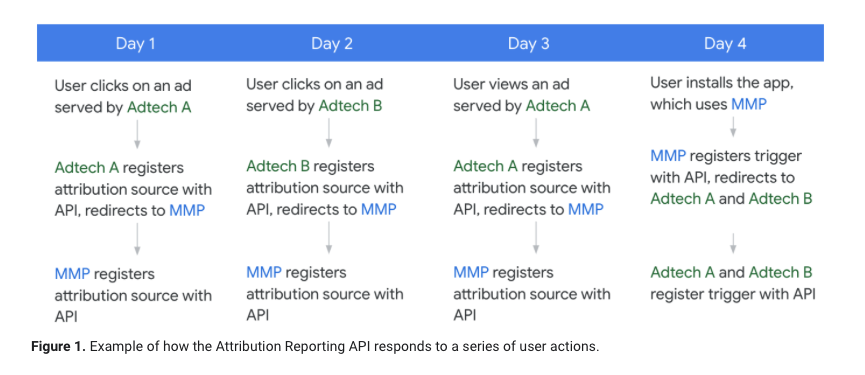Google updates Privacy Sandbox: explicitly details MMP role, web-to-app journeys
- Google updated Privacy Sandbox for Android documentation
- It’s pretty much as we’ve blogged
- Google explicitly acknowledges a role for MMPs in attribution
- Google shares web-to-app conversion paths
Unless you’ve been under a rock or been totally heads-down on your own growth initiatives, you know that Google announced Privacy Sandbox for Android about three months ago, saying at the time that Android’s ATT moment — the deprecation of the GAID — was inevitable.
Now we have more details on exactly what that future of attribution on Android looks like.
MMPs and Privacy Sandbox for Android
Google has broken it down in a simple timeline, and explicitly adds the concept of a mobile measurement partner (MMP) quarterbacking the attribution process.

In the real world, advertisers are running hundreds or thousands of campaigns with dozens of partners, meaning that issues around attribution and incrementality can get complicated. Google’s simplified example shows two adtech partners — one of which could be Google, but not necessarily — both running campaigns for a mobile app publisher.
A smartphone owner taps an ad from both ad networks while also viewing an additional ad later from one of them.
Interestingly, as we’ve talked about before, adtech providers can set the priority of what Google calls sources: clicks, views, and potentially other pre-install indicators. They are not the only ones, however. MMPs can also set priorities for sources.
Remember, in Privacy Sandbox for Android:
Sources = views and clicks
Triggers = installs, sign-ups, purchases
In the example above — and likely in many real-world scenarios, the ad networks prioritize clicks over views, as does the MMP. (Of course this could change in the case of video ads, in-game ads, audio ads, or other formats that are not standard clickable in-app ads.) For each adtech partner, the most recent high-priority source gets credit, so in spite of the fact that Adtech A in the image above registers both a click on Day 1 and an ad view on Day 3, the click gets the credit.
Attribution credit …
As currently set up, Privacy Sandbox for Android assigns attribution credit to each source, even if there’s only one install. In other words, both Adtech A and Adtech B get attribution notifications from Privacy Sandbox.
Google clearly states that both get credit for the one install:

However, only the MMP — which sees both sides — knows that both ad networks got those postbacks for the same install.
Since Google knows that everyone getting credit for everything is typically bad, ensuring an MMP is in the mix is a good idea to stop a new Privacy Sandbox form of click spam from getting credit for everything. And it’s also important to use deduplication keys:
“When an advertiser uses multiple ad tech platforms to register the same trigger event, a deduplication key should be used,” Google says. “The deduplication key serves to disambiguate these repeated reports of the same event. If no deduplication key is provided, duplicate triggers may be reported back to each ad tech platform as unique.”
While there’s no talk of multi-touch attribution (MTA) here, there’s clearly an emerging capability for an MMP, which sees all the sources and triggers, to provide a very nuanced view of an advertiser’s performance across all paid media partners, giving publishers much better visibility into how their ad campaigns deliver incremental impact. Expect some surprises here, and expect this to change how performance marketing campaigns are built and optimized.
Web-to-app as well as app to web and other combinations
Google also updated multi-channel app install customer journeys, saying that “all combinations of app- and web-based trigger paths are supported.” This of course makes perfect sense: while we’re primarily dealing with Privacy Sandbox on Android here, the entire effort is built on insight and technology that originates from where Privacy Sandbox was first seeded: the web.
That means …
- App to app
- App to web
- Web to app
- Web to web
… is all part of the plan from the beginning.

And that is precisely what we’ve been hoping for on the iOS side of the table, as we said in May of last year:
With Private Click Measurement, Apple gave us a tool to measure app to web journeys in SKAdNetwork. That’s great, but we also need tools to measure web-to-app journeys.
Getting it on Android makes it more likely that this will arrive on iOS, and since on iOS Apple — like Google on Android — controls the entire mobile operating system, it should be possible. Certainly in mobile Safari, but also in other browsers if a) Apple creates open APIs, and b) Google and other browser makers use them.
In any case, this is good to see from Google: there’s a clear path to high-quality privacy-safe advertising measurement and attribution on Android.
More on Privacy Sandbox for Android from Singular:
- Android’s SDK Runtime in Privacy Sandbox is a game changer
- Topics API: How Privacy Sandbox on Android connects people with ads
- FLEDGE in Privacy Sandbox on Android: reinventing the mobile ad network?
Also, here’s a new high-level video from Google for a quick introduction:
Stay up to date on the latest happenings in digital marketing


